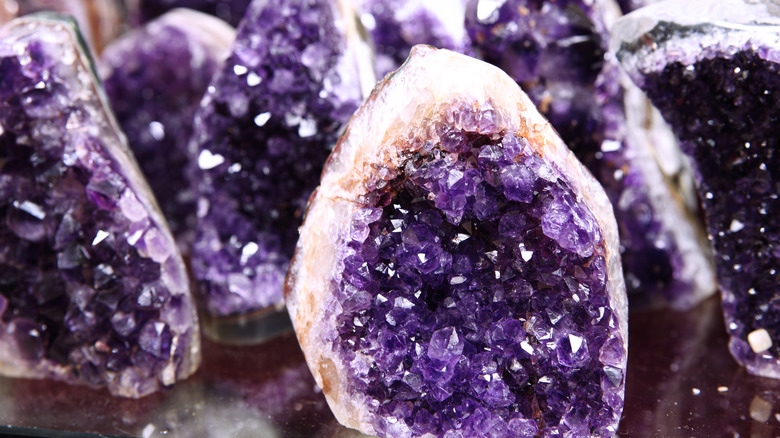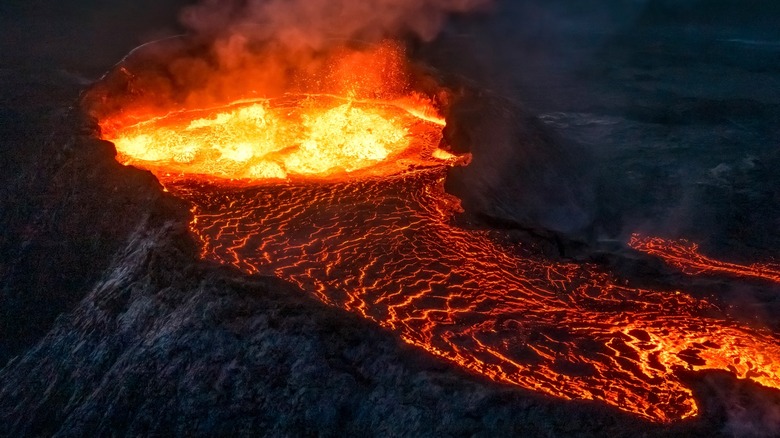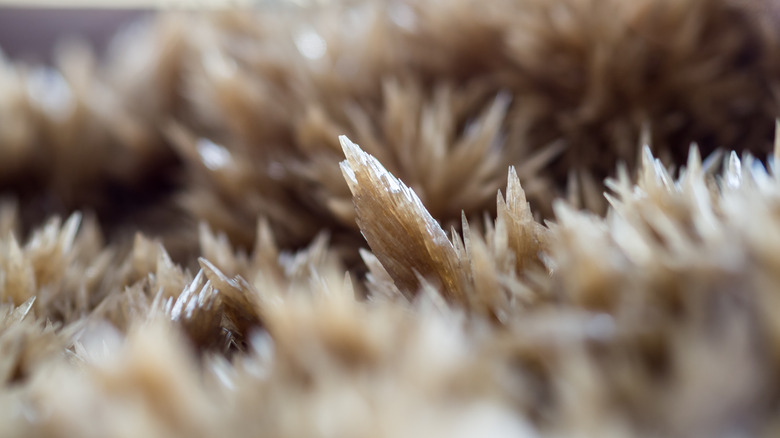This Is How Geodes Get Their Colors
Yes, humans sure do like shiny things. Head into any number of crystal shops and you're bound to see loads of colorful, polished stones, necklaces, salt lamps, yoga mats, incense, little Buddha statues, and much more. Some believe that crystals bestow "increased tranquility, positivity and focus," per Harpers Bazaar. Maybe the color matters, or the type, like how clear quartz is associated with "mental clarity" and used to "amplify psychic abilities," as The Spruce says. Other folks just think they're pretty. After all, crystals hide inside plain old rocks — at least they look like rocks. But really, they're geodes: a specific geological formation that takes thousands, even millions of years to form. The bigger they are, the older they are. And their colors? As the Carnegie Museum of Natural History says, those depend on the type of minerals that help form them.
The whole geode thing can get complicated, so it pays to clarify some terms. According to Michal and Company, some geodes contain crystals, some don't. Quartz is the most common type of crystal geode and comes in different colors like purple, aka amethyst. Other crystal geodes include pyrite, a semiconductor often called "fool's gold," celestite, and baryte. Non-crystal geodes include opal, which is composed of silicates and water and is smooth to the touch, not rocky, per Rock Your World. Agates, meanwhile, are similar to geodes but look like colored bands, not crystal clumps, per All Crystal. From here things get even more, shall we say, multifaceted.
Formed from lava and rainwater
The Carnegie Museum of Natural History gives us a brief version of how geodes and their colors form. Like many other geological phenomena, it all starts with volcanoes. When gases build up under Earth's surface, volcanoes erupt and spew out magma, gas, and ash. Lava is the term given to magma once it's on the surface and flowing, bubbling, roiling, etc. Lava is super-hot, molten, or semi-molten rock that is at least 1,300 degrees Fahrenheit and can reach 2,200 degrees. It's made of numerous elements, per USA Today, including oxygen, aluminum, calcium, silicon, iron, titanium, etc. There are also different kinds of lava based on temperature and composition.
But no matter how hot, lava cools. When it cools it hardens into a bumpy, rocky-looking surface. The surface isn't perfectly sealed, however, and when it rains water seeps inside. Rainwater carries minerals along with it as it flows, and when the water evaporates it leaves those minerals behind. Get enough of those minerals built up and viola: thousands or millions of years later, you have a geode.
As Michel and Company explain, the type of mineral carried along and left behind determines the color of geode. If there's a lot of magnesium and manganese, a crystal will look pink. Iron creates a "rusty red" color or purple, while titanium makes things blue. Depending on what it's mixed with, copper can produce red, green, or blue crystals. Nickel, meanwhile, makes crystals green. And if a crystal gets super hot it turns yellow-orange.
A thriving global industry
Geodes and colorful crystals seem so common that you'd be forgiven for thinking that their supply is infinite. Of course, that's not true, especially because as Geology.com tells us, folks buy "thousands of tons" of geodes every year. We've got polished, grab-them-by-the-handful crystals extracted from their stony shells, and the shelled kind made into things like bookends. We've got little geode kits with little hammers so people can feel like do-it-yourself prospectors. Museums and collectors house and display the more magnificent, expensive finds, while geodes at public events get cracked open to rousing applause and fanfare. Rockseeker says that small quartz or calcite geodes go for $4 to $12 a pop, while tiny golf ball-sized geodes can go for as cheap as $2. But gather enough of them together, and you've got a consistently strong industry.
As Geology.com says, the geode industry is especially strong in Mexico, Brazil, Uruguay, and Namibia, thanks to their particular geological histories. Miner's Den also tells us that geodes can also be found in areas with an abundance of limestone. In the U.S., states like Nevada, Arizona, Utah, and California are particularly geode-rich. This might help explain why a city like Sedona, Arizona is absolutely saturated with crystal shops and related merchandise, as Vogue explains. Then again, you can find geodes practically anywhere, especially quartz. So grab a pick and hammer if you'd like, keep your fingers crossed, and chip away to find your favorite color to admire.


